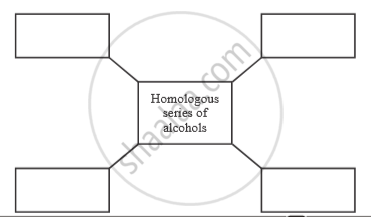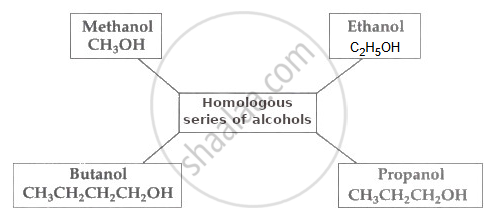Advertisements
Advertisements
Question
Write names of first four homologous series of alcohols.

Solution
Name of first four homologous series of alcohols.

RELATED QUESTIONS
Write the molecular formula of first two members of homologous series having functional group -Cl.
Write the molecular formula of the 2nd and 3rd member of the homologous series where the first member is ethyne.
Give the structural formula for 1, 2-dichloroethane
Complete the following table which relates to the homologous series of hydrocarbons.
|
General Formula |
IUPAC name of the homologous series | Characteristic bond type | IUPAC name of the first member of the series |
| `C_nH_(2n-2)` | (A)________ | (B)______ | (C)______ |
| C_nH_(2n+1) | (B)________ | (E)______ | (F)______ |
An organic compound having the molecular formula C3H6O can exist in the form of two isomers A and B having different functional groups. The isomer A is a liquid which is used as a solvent for nail polish. The isomer B is also a liquid. An aqueous solution of one of the lower homologues of B is used for preserving biological specimens in the laboratory
(a) What is compound A?
(b) Write the electron-dot structure of A.
(c) What is compound B?
(d) Write the electron-dot structure of B.
(e) Name the lower homologue of compound B which is used in preserving biological specimens.
 .
.
Distinguish between homologous organs and analogous organs. In which category would you place wings of a bird and wings of a bat? Justify your answer giving a suitable reason.
The phenomenon in which compounds having different structural formulae have the same molecular formula is called _______.
While going in an increasing order there is a rise in the molecular mass of the consecutive members of the homologous series by _______.
The general molecular formula for the homologous series of alkynes is _______.
Find the odd one out and give its explanation.
As one ascends in any homologous series, physical properties change gradually.
Complete the following table for the homologous series of alkanes.
| Name | Molecular formula | Condensed structural formula | Number of carbon atom | Number of -CH2- units | Boiling point °C |
| Methane | CH4 | CH4 | 1 | 1 | -162 |
| Ethane | C2H6 | CH3–CH3 | 2 | 2 | -88.5 |
| Propane | C3H8 | CH3–CH2–CH3 | 3 | 3 | -42 |
| Butane | C4H10 | CH3–CH2–CH2–CH3 | ______ | ______ | 0 |
| Pentane | C5H12 | CH3–CH2–CH2–CH2–CH3 | ______ | ______ | 36 |
| Hexane | C6H14 | CH3–CH2–CH2–CH2–CH2–CH3 | ______ | ______ | 69 |
Complete the following chart by using examples given in brackets.
(isobutylene, cyclohexane, propane, cyclohexene, cyclopentane, benzene, propyne, isobutane, propene)
| Straight chain hydrocarbons | Branched chain hydrocarbons | Cyclic hydrocarbons |
Which of the following pairs can be the successive members of a homologous series?
Which of the following does not belong to the same homologous series?
Name the following organic compound:
The first homologue whose general formula is CnH2n.
Define Homologous series.
Name the third homologue of alcohols.
Name the third homologue of aldehydes.
